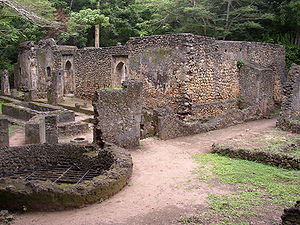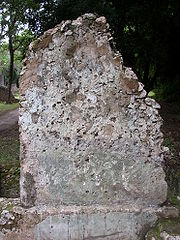
Ruins of Gedi
Encyclopedia


Swahili people
The Swahili people are a Bantu ethnic group and culture found in East Africa, mainly in the coastal regions and the islands of Kenya, Tanzania and north Mozambique. According to JoshuaProject, the Swahili number in at around 1,328,000. The name Swahili is derived from the Arabic word Sawahil,...
town located in Gedi, a village near the coastal town of Malindi
Malindi
Malindi is a town on Malindi Bay at the mouth of the Galana River, lying on the Indian Ocean coast of Kenya. It is 120 kilometres northeast of Mombasa. The population of Malindi is 117,735 . It is the capital of the Malindi District.Tourism is the major industry in Malindi. The city is...
in Kenya
Kenya
Kenya , officially known as the Republic of Kenya, is a country in East Africa that lies on the equator, with the Indian Ocean to its south-east...
.
From the 13th or 14th to 17th centuries, Gedi was a thriving community along the jungle coast of East Africa. Although no written record exists of this town, excavations between 1948 and 1958 revealed that the Muslim
Muslim
A Muslim, also spelled Moslem, is an adherent of Islam, a monotheistic, Abrahamic religion based on the Quran, which Muslims consider the verbatim word of God as revealed to prophet Muhammad. "Muslim" is the Arabic term for "submitter" .Muslims believe that God is one and incomparable...
inhabitants traded with people from all over the world. Some of the findings included beads from Venice
Venice
Venice is a city in northern Italy which is renowned for the beauty of its setting, its architecture and its artworks. It is the capital of the Veneto region...
, coins and a Ming vase from China
China
Chinese civilization may refer to:* China for more general discussion of the country.* Chinese culture* Greater China, the transnational community of ethnic Chinese.* History of China* Sinosphere, the area historically affected by Chinese culture...
, an iron lamp from India
India
India , officially the Republic of India , is a country in South Asia. It is the seventh-largest country by geographical area, the second-most populous country with over 1.2 billion people, and the most populous democracy in the world...
, and scissors from Spain
Spain
Spain , officially the Kingdom of Spain languages]] under the European Charter for Regional or Minority Languages. In each of these, Spain's official name is as follows:;;;;;;), is a country and member state of the European Union located in southwestern Europe on the Iberian Peninsula...
. The population was estimated to exceed at least 2500 people. These items can be found in the museum in the complex which was opened in 2000.
Gedi had a mosque
Mosque
A mosque is a place of worship for followers of Islam. The word is likely to have entered the English language through French , from Portuguese , from Spanish , and from Berber , ultimately originating in — . The Arabic word masjid literally means a place of prostration...
, a palace, and large stone houses. These houses were complex for their time, with bathrooms with drains and overhead basins to flush toilets. The city's streets were laid out at right angles and had drainage gutters. There are also wells which supplied water to the community. The material used to construct the buildings was made from coral reef from the nearby ocean.
In the early 16th century, the village was abandoned. A possible explanation was that a punitive expedition
Punitive expedition
A punitive expedition is a military journey undertaken to punish a state or any group of persons outside the borders of the punishing state. It is usually undertaken in response to perceived disobedient or morally wrong behavior, but may be also be a covered revenge...
came from Mombasa
Mombasa
Mombasa is the second-largest city in Kenya. Lying next to the Indian Ocean, it has a major port and an international airport. The city also serves as the centre of the coastal tourism industry....
against Malindi
Malindi
Malindi is a town on Malindi Bay at the mouth of the Galana River, lying on the Indian Ocean coast of Kenya. It is 120 kilometres northeast of Mombasa. The population of Malindi is 117,735 . It is the capital of the Malindi District.Tourism is the major industry in Malindi. The city is...
and forced the inhabitants to leave. A temporary reoccupation likely occurred by the nomadic Oromo
Oromo people
The Oromo are an ethnic group found in Ethiopia, northern Kenya, .and parts of Somalia. With 30 million members, they constitute the single largest ethnic group in Ethiopia and approximately 34.49% of the population according to the 2007 census...
tribe from Somalia in the late 16th century, who later abandoned the town.
It is unclear whether the actual name of the town was Gedi, Gede, or Kilimani. The Galla
Galla
Galla can refer to:* A derogatory name for the Oromo people of Ethiopia* Galla * Galla * Galla Placidia, daughter of Theodosius I* Galla of Rome, 6th-century saint* Gallu, a Mesopotamian demon...
word "Gede" means "precious", but the town might have been named after the last Galla leader to camp on the site.
In 1948, the remains of Gedi were declared a Kenyan national park. The ruins continue to be a popular tourist destination. Recently a tree house has been constructed in the center of the complex, around a giant tree near the main palace ruins. The site is usually open till 6 pm. There is also a small shop to buy drinks and souvenirs.
Legends
According to local tradition, the ruins are protected by the spirits of its priests. These "Old Ones" supposedly curse anyone who harms the site or removes anything.Further reading
- James Kirkman. 1975. Gedi. Historical monument. Museum Trustees of Kenya, Nairobi.
- James Kirkman. 1963. Gedi, the palace. Studies in African history, Mouton, Den Haag.
- James Kirkman. 1954. The Arab City of Gedi. Oxford University Press, Oxford. Rudolf Fischer. 1984. Korallenstädte in Afrika. Die vorkoloniale Geschichte der Ostküste. Edition Piscator, Oberdorf. pp. 107–121.
- Eric P. Mitchell. 2011. "Gedi: The Lost City Revisited" World Explorer Magazine, Vol. 6, No. 2, pp. 33–36.

